EMPEROR OF FOOD
Mopani worms stake a claim on the global stage
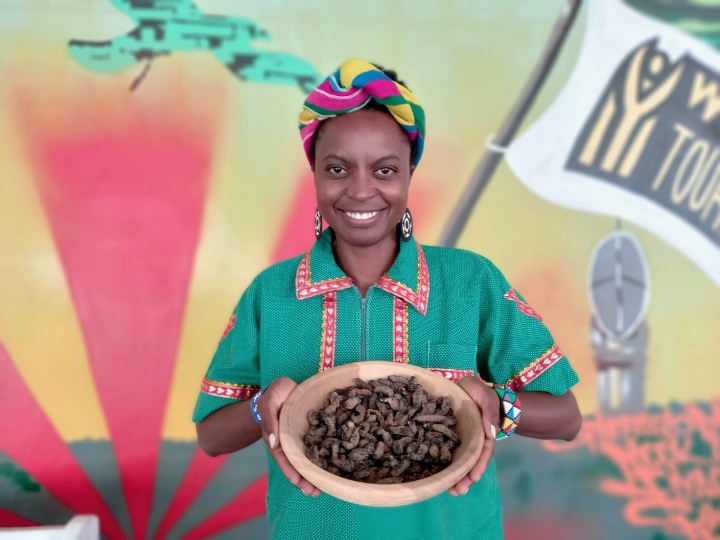
Insects. They are what we’re told we’ll all soon be eating if we care about the planet. For Wendy Vesela-Ntimbani, born in Limpopo, the mopani worm has been a culinary favourite since she was a kid. Now she is sharing them with the world. A cash cow disguised as a caterpillar?
Squeamish about what you eat? “Get over it!” That command came my way as I was about to bite into a mopani worm for the first time. It was Travel Indaba 2011 in Durban. The Limpopo stand, where a chef had cooked up a mopani stew. I was pondering whether to start by biting off the head or the tail. My face had apparently spontaneously squished into an expression of mild revulsion. The guest house owner, to whom I had confessed that I had never tried a mopani worm, was not going to have me worm my way out of this “opportunity”.
“Don’t scrutinise and analyse. Just eat it,” she barked. Then added: “They’re nutritious. They have protein and the skin gives you roughage.” Suitably reprimanded and a little ashamed even though her clinical description did nothing to whet my appetite, I took a deep breath. Then a bite. Into what could best be described as kind of like a well-cooked but not crispy prawn. Inside it was juicy with what looks like black blood and entrails and my stomach threatened to topsy-turn. Until the chef told me what I was experiencing, which had a gently smoky flavour, was tomato, onion and spinach. The worms had been gutted, boiled, salted, and sun-dried long before they had been kind-of reconstituted in the stew.
Fast-forward to Travel Indaba 2022, which was on in Durban last week.
“Will you have a worm?” my friend, Kathy, visiting Durban from California, asks. We’re at the Indaba opening night welcoming party, drinking our R55 a “glass”, small and plastic, of red wine. Kathy had come across the Limpopo stand and told me about this woman doing all kinds of interesting things with mopani worms. Kathy, no surprise, hadn’t heard of mopani worms before this encounter during her wanderings around the Indaba halls and stands. She has a couple of tiny three-worm sample packs.
“Sure,” I say.
Probably because they are the colour of biltong and are kind of chewy like biltong and salty-tasty like biltong, it strikes me that this is a really good bar snack. Very tasty. Very good to bite into. And so, the next day, I go back to find the mopani kiosk. See who the enterprising woman is, creating this culinary buzz.
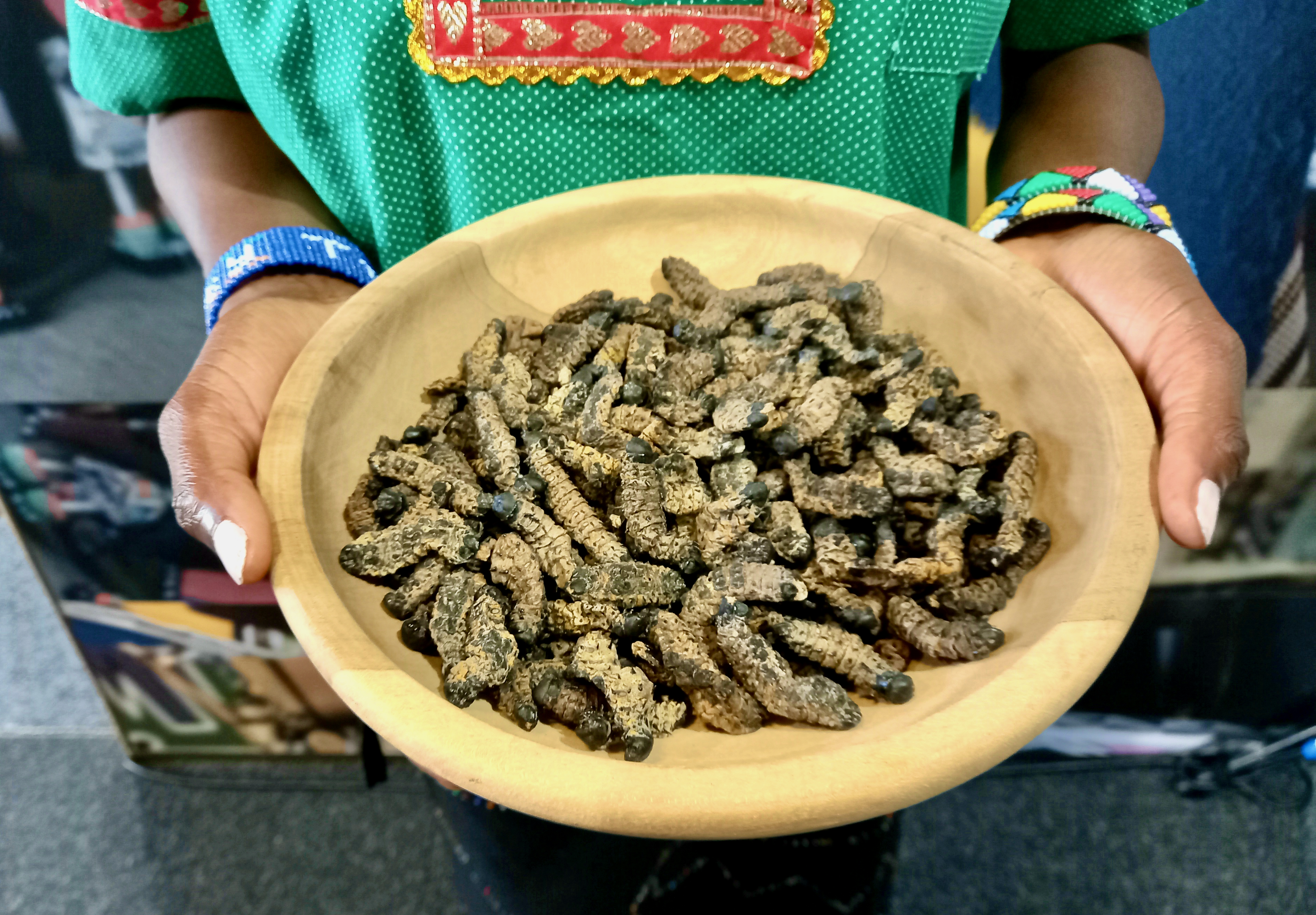
From Limpopo to the world, these mopani worms made their international culinary debut at the Travel Indaba in Durban. (Photo: Wanda Hennig)
Meet Wendy Vesela-Ntimbani, chemical engineer, entrepreneur, and a woman who, 10 years ago, around the time I was trying that stew, considered launching a mopani business. She wrote a business plan, which she mothballed. Felt the world wasn’t yet quite ready.
Now, however, insects, bugs – from ants and grasshoppers to termites and cicadas – are regarded as cutting-edge superfoods. Cricket flour is a norm in the United States and Europe. It’s the protein factor. But not just that.
When Covid hit, Vesela-Ntimbani was working as a supply chain manager, logistics and distribution. With all the job disruptions going on, “I thought, now I need to go back to my entrepreneurship. Pull out my business plan. And I was in.
“I follow trends. I know what is going on. Now, insects and insect protein are big. Cutting edge. By 2050 people are going to be eating insects because the food production of today is not going to sustain the population growth, estimated at nine to 10 billion in the next 30 years. That’s just around the corner.
“There are already companies, especially in Europe, starting to farm insects. You’re reading about the pet industry starting to use insect protein. You read about insects, insects, insects. That’s when I said, wait a minute. All the publications, they’re all talking about crickets, they’re all talking about buffalo worms, they’re all talking about mealworms. Okay. We need to bring mopani insects to the forefront because we have been eating these for generations and generations. But they are sitting off somewhere in the dark. Even for South Africans, you know… Like I was speaking to this gentleman, he’s Xhosa, I said “have a taste” and he’s like “oh my god, oh my god”…
“You don’t have to go far to see the resistance. I think it’s the fear factor.”
See our TGIFood article, Fruity ants, amadumbe and the present and future of food, for comments and discussion on insect cultivation and insects as superfood.
“We have an amazing product,” she says. “I call them mopani insects because when I say worms, people say no, no, no, no…”
They don’t mind insects?
“They think it’s better,” she laughs. (Let me insert here, when she remembers she calls them insects. Because mostly, she might mean to call them insects. But old habits die hard.)
Vesela-Ntimbani launched her mopani business a short six months ago. Speaking to her at the travel indaba, looking at her products, her branding, her range, her website and hearing her plans, it seems inconceivable that she won’t succeed in reaching her vision: To spearhead a protein diet revolution from southern Africa to the world that empowers local communities and does good for our planet.
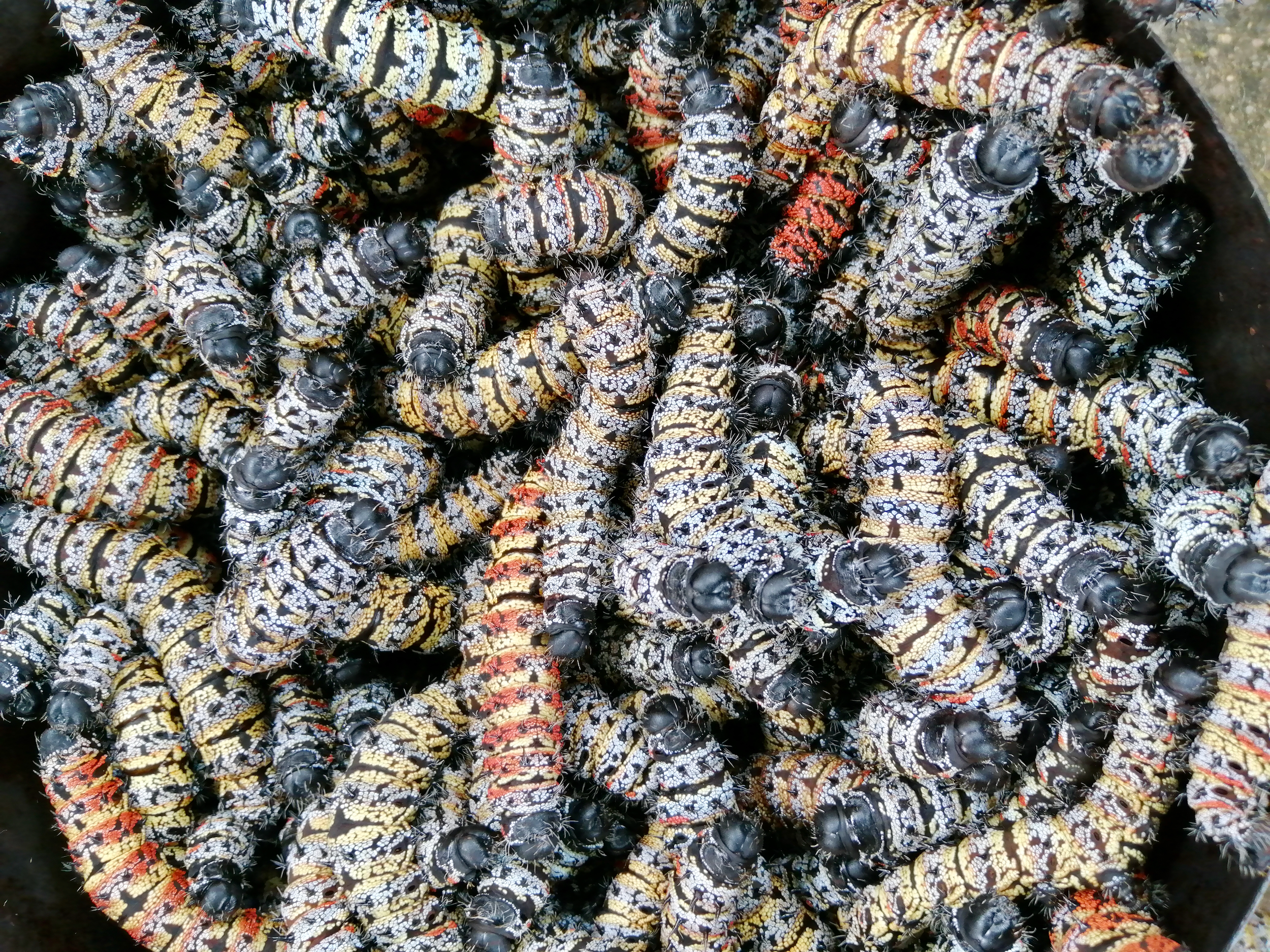
Plump, pretty and with 60% more protein than beef, fish or chicken, a mopani worm harvest. (Photo: Supplied)
Did she eat mopani worms growing up? “Yes. And harvested them. I come from an area where there are mopani trees, so every season, and the season is December, we go out to harvest. You aim to harvest as many as possible to sustain the family for the whole year, till the next season.”
Nature’s festive season offering was a family affair. It is mainly women who do the harvesting, but “my dad loves it. My mum and dad, they’re a team. When it comes to mopani insects, they go out together. I mean, we go out as a community, but they go together.” She chuckles and I get a picture of memories of community and happy times.
“At this most recent harvest, my mum and my dad went with me because I hired people and had a team. They were very excited. They were my assistants. I had to tell them, ‘you’re not employed. Let’s get that clear’,” she laughs.
That particular harvest was the initial action part of the business plan, which by then she had been working on for 18 months.
Back to growing up. “We would harvest them from the trees, gut them and cook them by means of boiling, put on salt because it is a preservative. Dry them in the sun. Store them in a cool, dry place.” Exactly the same process she is using now, on a larger scale and with bigger plans.
Was it possible to sustain the family with this annual harvest? “Yes, it is possible.”
However, stories abound these days of over-harvesting, environmental abuse and degradation, marauders coming in to ravage the trees for exploitation. And, of course, the effects of climate change. The mopani trees are essential if there are to be mopani worms. Read about the mopani worm life cycle here.
“Today we need to be very respectful of the environment and of our world and find new ways of doing things. That is one of the things we want to do as part of Matomani (the name of her business). So, how do we do this sustainability? Our plan is we are going to start farming mopani insects.” Among other things, planting more mopani trees and using greenhouses for incubation. “And instead of one harvest a year, we plan to create an environment for them to thrive and to have four harvests a year.”
She says she will likely work at some point with an entomologist, moving forward. Her speciality as an engineer is processes. “Once the process is up and running and the cycle is mastered, it will all run pretty smoothly.” But all that, right now, is “the future”.

For generations the people of Limpopo and other nearby regions, which have mopani trees, have been eating these insects. (Photo: Supplied)
“We’ve been eating these for decades,” says Vesela-Ntimbani. “I’ve been eating them for years. I have them in my house, always. They are a sustainable, alternative supply of protein. Look at what farming is doing to our planet. How do we become conscious consumers? You can get protein that is good for you in places other than what you see sitting in the supermarket aisle.
“The more I read, starting this business became a no-brainer. I saw the time to introduce them, to bring them to people’s pantries, is now. But then the question was, how do I get people to start consuming them, to start eating them?”
While not vegan or vegetarian, “interestingly enough, when I was doing the research, I learned that 50% of vegetarians will eat insects. It’s not an animal that is being killed. Sustainably harvesting mopani worms, you’re not harming the planet. So people looking for alternative sources of protein, or who are cutting down on meat and becoming environmentally conscious are interested. And we’re keeping them as natural and organic as possible”.
Her idea was to show up with a bang. To have a beautifully packaged product, the branding appealing and inspired by her Tsonga roots. Her intention being to have consumers say, wow, I want to try that.
She also knew she needed to offer multiple and different products using mopani worms. “To get people to start eating something, you have to offer it in a form people will understand. So, many people will have a protein smoothie at home or fruit yoghurt for breakfast.
“The stone-ground mopani flour can be added to these for a good dollop of protein.” I tried a tablespoon of the flour on plain yoghurt and found it yeasty and tasty.
She experimented with recipes, some of which she has on her website.
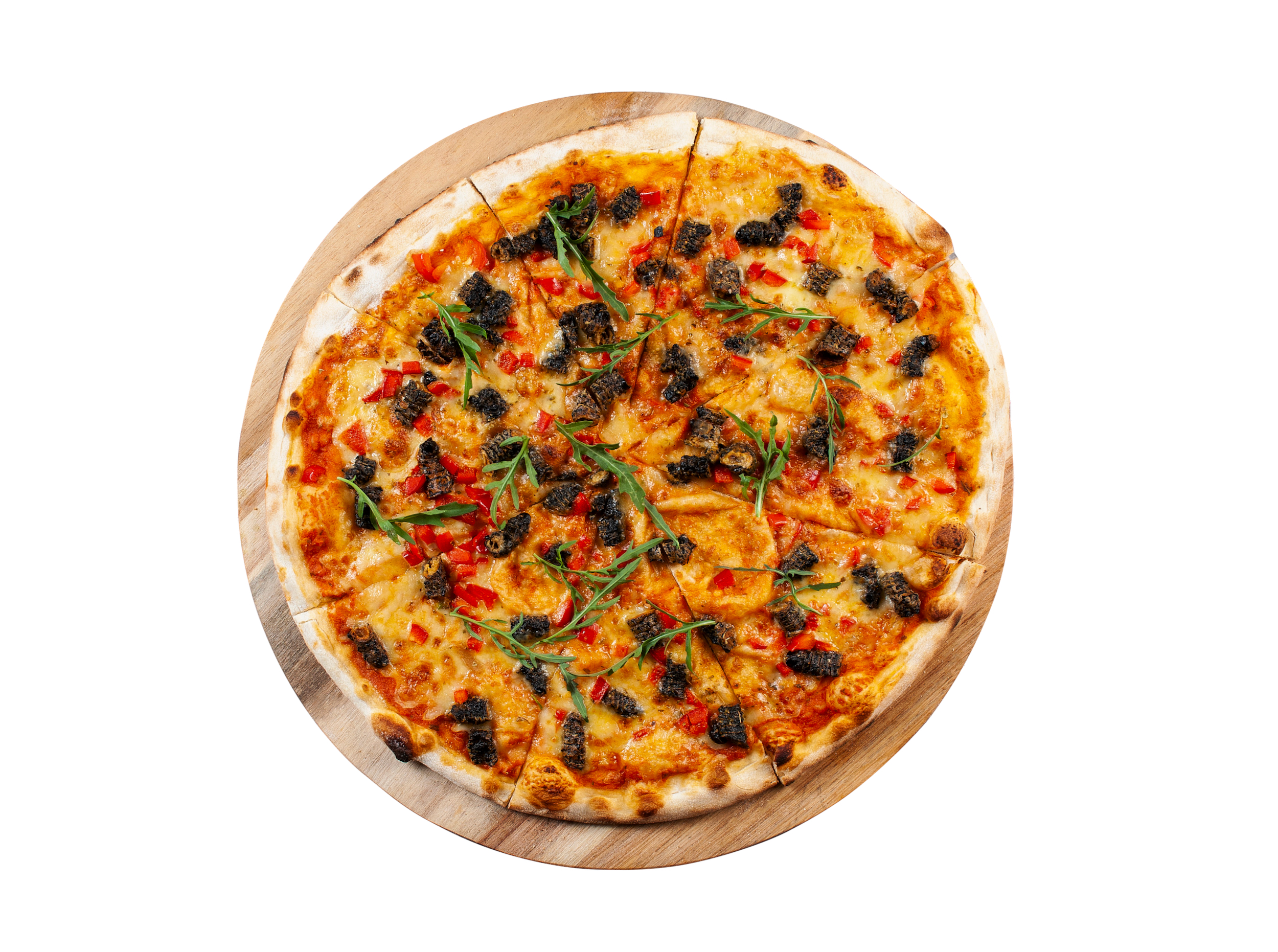
Mopani worm pizza, the base made with stone ground mopani worm flour. (Photo: Supplied)
See her traditional Tsonga mopani stew recipe and her mopani pizza recipe.
“Pancakes can work well with 100% mopani flour. But if you want things to rise in the oven, you need flour at a ratio of ⅓ (as in one part mopani flour to three parts regular flour). So you can use your usual recipe for scones, for muffins, for a cake and just balance it out.” She suggests adding both a handful of worms and a tablespoon of flour to a salad, which sounds good. I tried a small biscuit sample. Appreciated its lack of sugar. It made me think “dog biscuit”. I felt virtuous eating it.
“For years mopani worms have been available in the informal markets in Limpopo and neighbouring areas. But they have not been easily accessible for middle class and upper class consumers.”
She is delighted to report that her Matomani website is starting to show up on Google when people look for alternative sources of protein, natural protein, organic protein. She is active on social media. “Then we have them on Takealot. We have them in two shops in Pretoria, one in Johannesburg, three in Limpopo. After Indaba, we’ll have them in a lot more places. We’ve specially had interest from people who have hotels and lodges.”
Early in 2023, the idea is to have a proper processing plant that complies to all the food regulations, including for export. She has already had them tested by the standards authority that supplies formal nutritional information, listed on the back of each packet. Protein, zinc and iron score especially high. They have three times as much protein as beef, chicken or fish. “So in this 100g package of mopani flour, 60g is protein.”
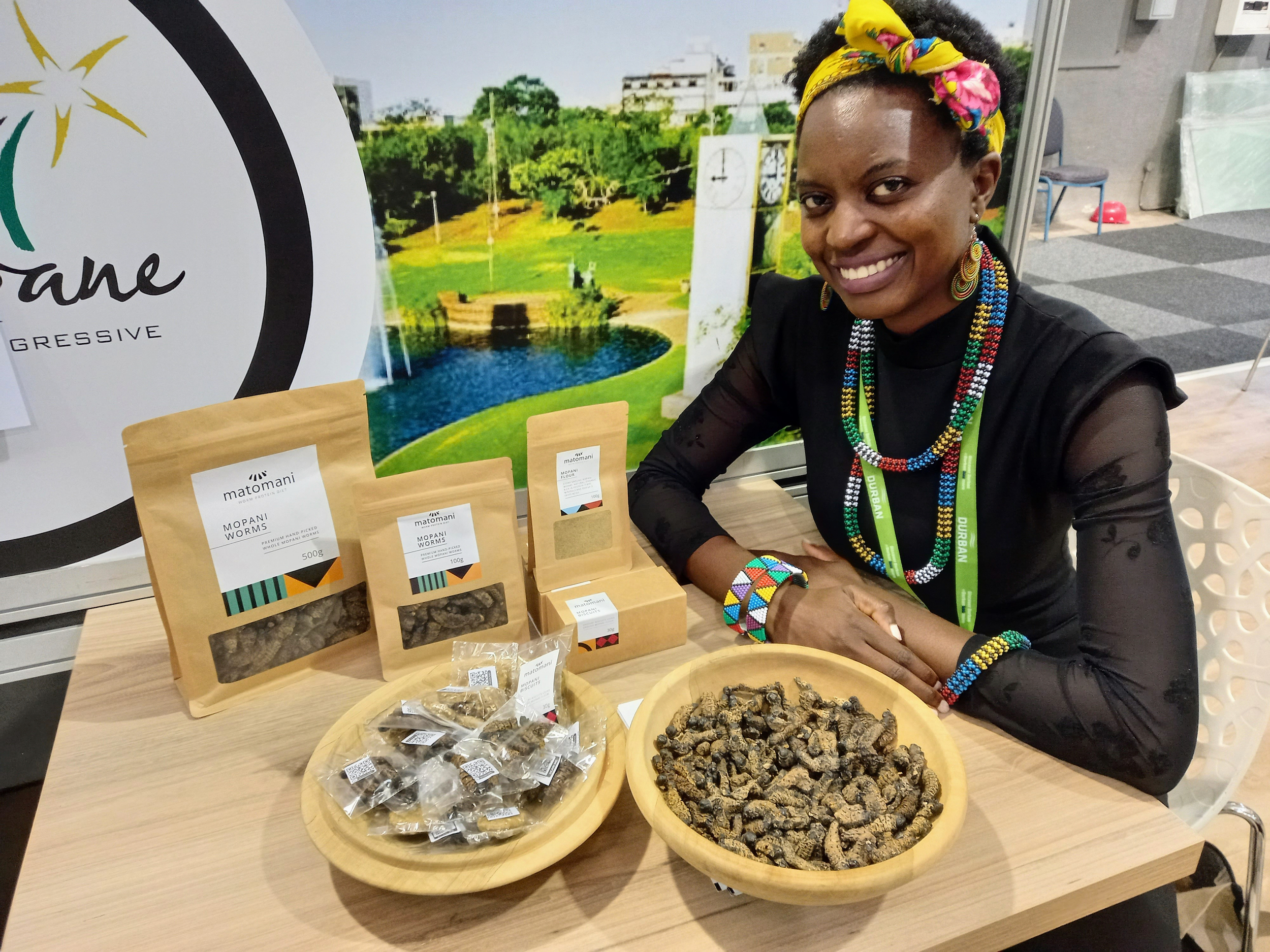
Wendy Vesela-Ntimbani at Indaba shares samples of her early product range. (Photo: Wanda Hennig)
Vesela-Ntimbani, her husband and two sons, aged 10 and 12, live in Lanseria, Johannesburg. “But I am from Limpopo province and that’s still home, and where all of this comes from.” She indicates her range on her table at Indaba.
To take a trip back to life before her mopani business, Vesela-Ntimbani went to primary school in a rural village called Kheyi (“pronounced K, like the letter”) near Phalaborwa. Completed high school in Phalaborwa, which is where her company is based.
Her excellence in maths and science got her accepted at the University of Johannesburg to study chemical engineering. “It interested me. Back then, there was a big book in the library that was our career guidance resource.” Looking through it, she was drawn to the engineering section. “Something about the processes and materials and products. I always want to know how products are made. How does this cup come to be, for instance?” She holds up her coffee cup, turns it round, eyes it with curiosity. Chemical engineering spoke to her curiosity.
After graduating Vesela-Ntimbani worked at SAB for five years, where she met her chemist/brewer husband. They married then moved to the Czech Republic, Prague, for five years. Then to Switzerland for three, where she worked for a large pharmaceutical company.
“Then we came back to South Africa,” and the question became, what was she going to do? This is when she drew up her mopani business plan. “I had always had an interest in my own business. While I was in Europe I got introduced to online shopping and when we came back, I started an online shop. Fashion retail.” She did that for five years. Before the job that she was doing when Covid knocked us all for a loop.
She is, now, looking for funding. “So far I have self-invested and one of the reasons small businesses fail, the founder runs out of capital. I think this is an amazing product, so I don’t want that to happen.”
When I ask if she dishes up mopani at home, it’s a bit of a joke. “The other day one of my kids said, can we eat anything else other than mopani worms?!” One of the first things her parents did when she took her Czech husband-to-be to meet them was, “they fed him. Yes, of course, mopani worms…”
Now, she is set on sharing her mopani worms with the world. A cash cow disguised as a caterpillar? Follow her on social media to track her progress. DM/TGIFood
Visit Matomani on Instagram, on Facebook and on their website.
Follow Wanda on Instagram wanda_hennig





 Become an Insider
Become an Insider
Please start a training program for mopani worm collectors. In Zambia I saw dozens of trees that had been chopped down to make harvesting easier.
I really hope your business thrives and grows. Export market waiting to happen.